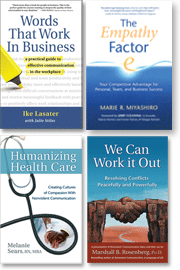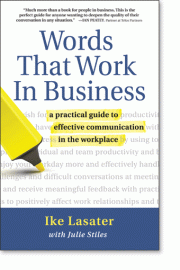Transforming Enemy Images in the Workplace, continued
I like to work with enemy images because I do not like how I feel going about my daily life when I have them, or how I act when I’m thinking in enemy images and experiencing the feelings that are consistent with those thoughts.
These are examples of enemy images:
- She does not care.
- He is aggressive.
- They are out to get me.
- She is really smart.
- He is better than me.
- I screwed up.
- I am great.
- He is crazy.
All of these statements have a commonality -- they put yourself or others into a static box labeled with who or what they are.
The two main problems with enemy images are that they dehumanize and they tend to create exactly what I don’t want.
By dehumanize, I mean that any time we label someone in a static way, we limit their full humanity and then tend to interact with them out of this diminished idea of who they are. In doing so, we often find our expectations are borne out. For instance, if you go into a meeting with the expectation of a hostile reception, you will likely act and speak in ways that increase the likelihood that you will be received in the way you fear.
Now, you might be thinking, “So what if I think my boss is a jerk? As long as I don’t say or do anything to act on the thought, it doesn’t matter.”
In my experience, however, it matters a lot. In the mediation work that I do, when I have a judgment in my head, I can see disconnection beginning to happen in the room within moments. Whenever a person has a thought that they do not consciously disbelieve, their neurological system will release neurotransmitters that are consistent with that thought. Thus, our thoughts affect our feeling state, which in turn affects our micromovements, the rhythm of our speech, the words we choose, and the energy with which we deliver them. All of that together communicates on an unconscious level.
Once we are clear that we want to work with enemy images, the process is similar to other NVC processes. The first step is awareness: to realize that I have such judgments.
The idea behind the enemy image process is that if I’m having a judgment, it is an expression of unmet needs. In doing this process, I shift to evaluating whether my needs are met or not. If I can translate the judgment into the needs not met, I will have tapped into the power of the mind, once directed to what is desired, to diligently search for strategies that will meet my needs.
Self-empathy and silent empathy are the central components to the enemy image process. I get my need for empathy met by identifying the need or needs that I’m seeking to meet by making a judgment.
This is not an analytical process; instead, ask the question gently, perhaps with a list of needs in front of you. In a musing frame of mind, query yourself as to whether it might be this need or that need. This is typically an iterative process in which the self-inquiry is repeated over and over again; with each response, you use changes in your felt sense to guide you in further guesses as to what the need might be.
If I’m having a judgment of somebody else, then I practice silent empathy, which shifts the focus of my attention onto the needs of the other person by guessing what needs they might be seeking to meet by the conduct that I am judging. I do not have to be “right” about my guesses; the important thing is that I focus my attention on their needs as the motivation for their conduct. I am satisfied with this part of the process when I feel a certain resonance with my guess.
In the workplace, the opportunity to use the enemy image process comes up frequently.
For example, you might have an interaction with a co-worker that results in hurt feelings on both sides. In thinking about reengaging with that person, you become aware of having judgmental thoughts. You might want to use the enemy image process so that when you do attempt to reengage, you will not be leaking your judgments through your body language, words, and tone of voice. Since your need for empathy will have been met, you will be more likely to be able to listen to the other person before needing to be heard yourself.
Marshall Rosenberg refers to this as “empathy before education.” We are more likely to get our needs met when we are sufficiently open to hearing and connecting with the needs of others, when we help them get their need for empathy met before we try to express ourselves.
Another prime situation for using the enemy image process is in relation to a boss. When someone has authority over us—when their conduct can affect our well-being and our needs for sustainability through continuing employment—we often hold certain beliefs and judgments about them. These judgments can affect how we interact, and using the enemy image process helps keep our communication from becoming muddied with our fears and beliefs.
The enemy image process can be applied in many other workplace situations as well, and in this book we cover more specifics on such topics as humor, prejudice, power differentials, gossip, feedback and evaluations, workplace cleanliness, broken agreements, and termination of employment.
Ike Lasater, J.D., MCP, is the author of Words That Work In Business, a former attorney and cofounder of Words That Work, a consulting and training firm helping organizations achieve results through better communication and collaboration (www.wordsthatwork.us). He has worked with individuals and organizations in the US, Australia, Hungary, New Zealand, Pakistan, Poland and Sri Lanka. He is a former board member for the Center for Nonviolent Communication, and the Association for Dispute Resolution of Northern California, and the co-founder of the Yoga Journal magazine.
Keep learning these vital communication skills with these books and training resources:
This Month's Specials:
- NVC Workplace Communication Book Package - Save 50% off list price through August 30, 2010
- NVC Reference Library Package - Save 60% off list price through August 30, 2010
Every Day Specials:
- Words That Work In Business - Save 30% on this book every day from PuddleDancer Press
- We Can Work It Out - Save 30% on this booklet every day from PuddleDancer Press
- What's Making You Angry? - Save 30% on this booklet every day from PuddleDancer Press
- NVC Marshall Rosenberg Package - Save 45% on this book package every day from PuddleDancer Press
- NVC Starter Kit Book Package - Save 40% on this book package every day from PuddleDancer Press








